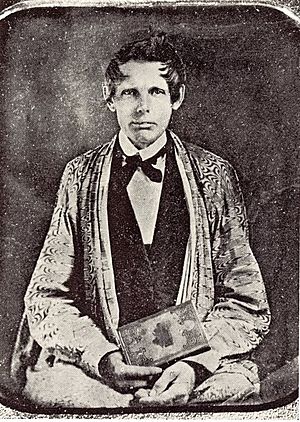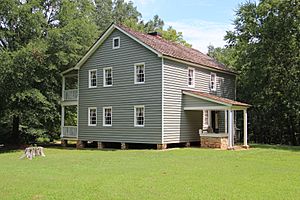Samuel Worcester facts for kids
Quick facts for kids
Samuel Worcester
|
|
|---|---|

Samuel Worcester, "Cherokee Messenger"
|
|
| Born |
Samuel Austin Worcester
January 19, 1798 Peacham, Vermont, U.S.
|
| Died | April 20, 1859 (aged 61) |
| Alma mater | University of Vermont |
| Occupation | Minister, linguist, printer, cofounder of Cherokee Phoenix newspaper |
| Spouse(s) |
Ann Orr
(m. 1825–1839)Erminia Nash
(m. 1842–1850) |
Samuel Austin Worcester (born January 19, 1798 – died April 20, 1859) was an American missionary. He worked with the Cherokee people. He helped translate the Bible and set up printing presses. He also strongly supported the Cherokee's right to govern themselves.
Worcester worked with Elias Boudinot, a Cherokee leader. Together, they started the Cherokee Phoenix newspaper in Georgia. This was the first newspaper published by Native Americans. It was printed in both English and the Cherokee language. The Cherokee people called Worcester A-tse-nu-sti, which means "messenger."
Worcester was arrested in Georgia. He broke a state law that said white missionaries needed a special license to live on Cherokee land. He took his case, called Worcester v. Georgia (1832), to the U.S. Supreme Court. The Court decided that Georgia's law was against the U.S. Constitution. Chief Justice John Marshall said that only the U.S. government, not states, could deal with Native American nations. He also said that Native American nations had the right to govern themselves. However, President Andrew Jackson and Georgia's Governor George Gilmer did not follow this ruling.
Worcester was later set free. He moved to Indian Territory in 1836. This was during the time when many Cherokee people were forced to move on the "Trail of Tears." His first wife died there in 1839. Worcester continued his missionary work. He kept translating the Bible into Cherokee. He also set up the first printing press in that area. He helped the Cherokee publish their newspaper in both Cherokee and English. In 1963, he was honored in the Hall of Great Westerners.
Contents
Early Life and School
Worcester was born in Peacham, Vermont, on January 19, 1798. His father, Leonard Worcester, was also a minister and a printer. Samuel learned about printing from his father. In 1819, he graduated from the University of Vermont.
Samuel Worcester became a Congregational minister. He decided he wanted to be a missionary. After finishing his studies in 1823, he hoped to go to India or other faraway places. But the American Board of Commissioners for Foreign Missions (ABCFM) sent him to the American Southeast. His job was to work with the local Native American tribes.
Family Life and Work
Worcester married Ann Orr. They moved to the Brainerd Mission in August 1825. This is where he began his work with the Cherokee. The ABCFM wanted the Cherokee to learn English, live like Americans, and become Christians. But other missionaries knew they first needed to learn the Cherokee language.
While at Brainerd, the Worcesters had their first child, a daughter. Two years later, they moved to New Echota. This town became the capital of the Cherokee Nation in 1825. There, Worcester worked with Elias Boudinot. They started the Cherokee Phoenix newspaper. It was the first newspaper published by a Native American nation. It used the syllabary (a writing system where each symbol is a syllable) created by Sequoyah for the Cherokee language. It was also printed in English.
Samuel and Ann Worcester had seven children together: Ann Eliza, Sarah, Jerusha, Hannah, Leonard, John Orr, and Mary Eleanor. Ann Eliza later became a missionary, just like her father.
The Cherokee Phoenix Newspaper
Worcester was greatly impressed by a young Cherokee man named Oowatie. He later took the English name Elias Boudinot. Boudinot had gone to school in New England. He was also the nephew of Major Ridge, an important Cherokee leader. Worcester and Boudinot became good friends.
A Cherokee man named Sequoyah had created a special writing system for the Cherokee language. This was a huge achievement because his people did not have a written language before. The Cherokee people admired written papers, calling them "Talking Leaves."
Boudinot asked Worcester to use his printing skills to start a Cherokee newspaper. Worcester believed the newspaper would help the Cherokee people learn to read and write. He also thought it would bring the Cherokee Nation closer together. He wrote about the newspaper's goals. It would publish Cherokee laws, stories about their customs, and daily news.
Worcester used his missionary connections to get money for the newspaper. He bought a printing press and ink. He even made the metal type for each of the 86 characters in Sequoyah's syllabary. The first Cherokee Phoenix newspaper was printed on February 21, 1828, in New Echota (now Calhoun, Georgia). This was a very important moment for Native Americans.
The Cherokee people gave Worcester the name A-tse-nu-tsi. This name means "messenger."
Worcester's Court Case and Time in Prison
More and more white settlers wanted to move onto Cherokee land. The Cherokee, with help from Worcester and his missionary group, decided to fight this in court. They wanted the U.S. Supreme Court to decide who had power over their land: the federal government or the state of Georgia. They also wanted the Court to confirm that the Cherokee Nation had the right to govern itself.
The Cherokee hired William Wirt, a former U.S. Attorney General. They argued their case in Cherokee Nation v. Georgia (1831). The Court did not rule in their favor that time. Chief Justice Marshall said the Cherokee Nation was a "domestic dependent nation." This meant they were under the protection of the U.S. but did not have full power over states.
Worcester and eleven other missionaries met in New Echota. They protested a Georgia law from 1830. This law said white men could not live on Native American land without a state license. Worcester believed that obeying this law would mean giving up the Cherokee Nation's right to control its own land. So, he refused to get a license.
Georgia's Governor George Rockingham Gilmer ordered the militia to arrest Worcester and the others. After two trials, all eleven men were found guilty. They were sentenced to four years of hard labor in prison. Nine of them accepted pardons and were set free. But Worcester and Elizur Butler refused their pardons. They wanted their case to go to the Supreme Court.
William Wirt argued their case. Georgia refused to send a lawyer, saying no Native American could force it into court. In late 1832, the Supreme Court ruled that the Cherokee Nation was independent. It said only the federal government could deal with Native American nations. The Court canceled Worcester's and Butler's convictions.
However, President Andrew Jackson did not agree with the ruling. He wanted Native Americans to move west. Governor Gilmer also kept Worcester and Butler in prison.
The next governor, Wilson Lumpkin, took office. He was dealing with a big problem with South Carolina. He decided to free Worcester and Butler. They agreed to leave Georgia and not return. Worcester felt that even though he won in court, the larger fight was lost. The state and settlers would not follow the Supreme Court's decision. Within three years, the U.S. military forced the Cherokee Nation to move west of the Mississippi River. This sad journey is known as the "Trail of Tears."
Life After Prison
After being released, Worcester and his family decided to move to Indian Territory. They wanted to be there when the Cherokee people arrived. In 1835, they moved to Tennessee for a short time. Then, in 1836, they began their long journey by boat. They lost many of their belongings when a steamer sank. The trip to the Dwight Presbyterian Mission in Indian Territory took seven weeks. During this time, Ann, Worcester's wife, became sick with a fever.
At Dwight Presbyterian Mission, Worcester continued to preach to the Cherokee who had already moved there. In 1836, they moved to Union Mission, and then finally to Park Hill. Worcester worked hard. He set up the first printing press in that area. He translated the Bible and many hymns into Cherokee. He also ran the mission. In 1839, his wife Ann died.
Worcester stayed in Park Hill. He married Erminia Nash in 1842. He worked to help solve problems between the Cherokee who had moved from Georgia and the "Old Settlers" who were already in Indian Territory. Samuel Worcester died in Park Hill, Indian Territory, on April 20, 1859.
Worcester House

The Worcester House is the only original building still standing from the old Cherokee community of New Echota. Other buildings were destroyed by settlers after the Cherokee were forced to leave in 1838. The Worcester house was built in 1828.
The Worcesters lived in the house from 1828 to 1834. Then, a Georgian took ownership of it in the 1832 Land Lottery. Many Georgians owned the house over the years. In 1952, the house was given to the state of Georgia. In 1954, it went to the Georgia Historical Commission. Today, it is managed by the Georgia State Parks and Historic Sites.
In 1962, the New Echota Historic Site opened to the public. In 1973, it became a National Historic Landmark District. The Cherokee Council House was rebuilt there. The site helps people learn about Cherokee history and culture.
See also

